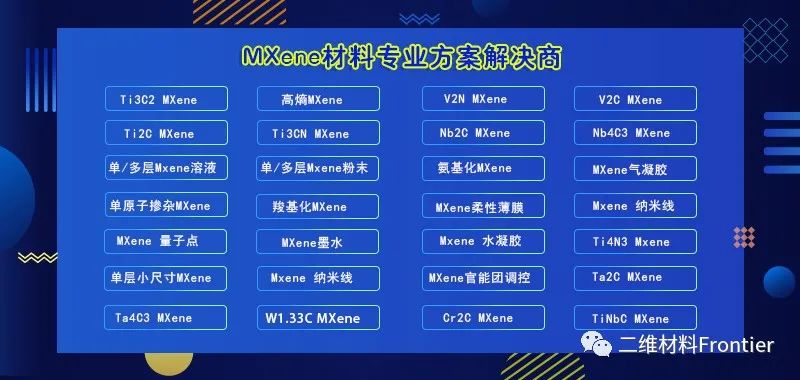Chem. Eng. J.|Monodisperse MXene quantum dot edge active sites promote HER performance
QQ Academic Group: 1092348845
Detailed
North Konami can provide monodisperse MXene quantum dots (customizable)

Research abstract
picture
The nanostructure engineering of 2D MXenes is instructive for the design of non-precious metal electrocatalysts for HER. Nevertheless, the limited active site density and activity of the MXene basal plane greatly limit the electrocatalytic performance. In view of this, the research team of Huazhong University of Science and Technology Zhang Jian, Wuhan University of Technology Xueyuan Yang, Kou Zongkui published the latest research results in Chemical Engineering Journal. active sites to enhance HER performance. Meanwhile, the generality of this method is demonstrated by extending to other MXene-based quantum dots, including M-Ti3C2 QDs, M-V2C QDs, S-Nb2C QDs, M-Nb2C QDs, where M and S represent respectively Multilayer or monolayer MXene nanosheets. Taking Ti-based MXene as an example, the monodisperse QDs exhibited 13.7 times the activity of pure phase MXene nanosheets, while also showing good stability. This paper argues that the edge metal atoms of QDs are more favorable for binding to the intermediate H*, resulting in a lower energy barrier, which is especially beneficial for hydroxyl-functionalized functional groups.
Graphical guide
picture
Figure 1. Schematic diagram of the synthesis process and microstructure characterization of 0D Ti3C2Tx QDs.
picture
Figure 2. Structure, morphology, size distribution and AFM images of M-Ti3C2 QDs, M-V2C QDs, S-Nb2C QDs, and M-Nb2C QDs.
picture
Figure 3. Structure and XPS spectra of 0D Ti3C2 QDs.
picture
Figure 4. HER electrochemical performance of Ti, V and Nb-based MXene quantum dots.
picture
Figure 5. Theoretical models and Gibbs free energies of edge sites and basal planes for Ti, V and Nb-based MXene quantum dots.
Summarize
picture
The 2D MXene nanosheets were transformed into 0D quantum dots through a Li intercalation strategy to promote active edge sites and lower the energy barrier. The HER performance of monodisperse MXene quantum dots is several times higher than that of the corresponding pristine MXene nanosheets, and still has excellent stability after 2000 cycles. This study shows that the metal atoms at the edge of MXene quantum dots have better HER catalytic activity than the basal plane atoms, especially for hydroxyl-functionalized MXenes, which points out the direction for the low-dimensional design of MXene-based HER catalysts.
picture
Literature link
https://doi.org/10.1016/j.cej.2022.136119
For the original text, please click the lower left corner of the tweet to read the original text

Research abstract
picture
The nanostructure engineering of 2D MXenes is instructive for the design of non-precious metal electrocatalysts for HER. Nevertheless, the limited active site density and activity of the MXene basal plane greatly limit the electrocatalytic performance. In view of this, the research team of Huazhong University of Science and Technology Zhang Jian, Wuhan University of Technology Xueyuan Yang, Kou Zongkui published the latest research results in Chemical Engineering Journal. active sites to enhance HER performance. Meanwhile, the generality of this method is demonstrated by extending to other MXene-based quantum dots, including M-Ti3C2 QDs, M-V2C QDs, S-Nb2C QDs, M-Nb2C QDs, where M and S represent respectively Multilayer or monolayer MXene nanosheets. Taking Ti-based MXene as an example, the monodisperse QDs exhibited 13.7 times the activity of pure phase MXene nanosheets, while also showing good stability. This paper argues that the edge metal atoms of QDs are more favorable for binding to the intermediate H*, resulting in a lower energy barrier, which is especially beneficial for hydroxyl-functionalized functional groups.
Graphical guide
picture
Figure 1. Schematic diagram of the synthesis process and microstructure characterization of 0D Ti3C2Tx QDs.
picture
Figure 2. Structure, morphology, size distribution and AFM images of M-Ti3C2 QDs, M-V2C QDs, S-Nb2C QDs, and M-Nb2C QDs.
picture
Figure 3. Structure and XPS spectra of 0D Ti3C2 QDs.
picture
Figure 4. HER electrochemical performance of Ti, V and Nb-based MXene quantum dots.
picture
Figure 5. Theoretical models and Gibbs free energies of edge sites and basal planes for Ti, V and Nb-based MXene quantum dots.
Summarize
picture
The 2D MXene nanosheets were transformed into 0D quantum dots through a Li intercalation strategy to promote active edge sites and lower the energy barrier. The HER performance of monodisperse MXene quantum dots is several times higher than that of the corresponding pristine MXene nanosheets, and still has excellent stability after 2000 cycles. This study shows that the metal atoms at the edge of MXene quantum dots have better HER catalytic activity than the basal plane atoms, especially for hydroxyl-functionalized MXenes, which points out the direction for the low-dimensional design of MXene-based HER catalysts.
picture
Literature link
https://doi.org/10.1016/j.cej.2022.136119
For the original text, please click the lower left corner of the tweet to read the original text
- Previous: NML: In-situ polymeriz
- Next: MXene breakthrough: Na


 mxene academic
mxene academic